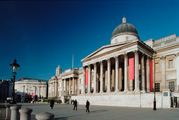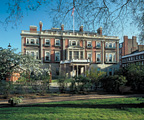The Art of the Poster – A Century of Design
Originally published in January 2009 in American in Britain Magazine
Come on down to Covent Garden where the London Transport Museum is celebrating one hundred years of original poster art – a century of design excellence. You will see sixty posters chosen from an archive of nearly 5000. Each one was commissioned from fine artists and graphic designers to publicise the Capital’s public transport network.
THE ART OF THE POSTER – A CENTURY of DESIGN
By Abby Cronin
Come on down to Covent Garden where the London Transport Museum is celebrating one hundred years of original poster art – a century of design excellence. You will see sixty posters chosen from an archive of nearly 5000. Each one was commissioned from fine artists and graphic designers to publicise the Capital’s public transport network. At the beginning of the 20th century Underground travel was a technological breakthrough and posters helped to educate and encourage passengers to use the new system. The exhibition celebrates the pioneering role of London Underground as a patron of poster art. It begins with Edwardian pictorialism, includes exceptional examples of early 20th century modernist designs, and post-war themes by outstanding contemporary painters and graphic artists. Every poster aims to communicate, inform and sell modern Underground services for both work and leisure pursuits.
It is hardly surprising that one hundred years ago Londoners were somewhat fearful of descending on electric lifts to deep-level platforms to catch a train. Many commuters were somewhat intimidated by the novelty of travelling so far below street level. Traditional modes of transport – bus, tram and rail felt safer. The problem was to find a strategy to demystify tube travel and entice people to use the underused system. Frank Pick, responsible for the Underground Group’s publicity, launched a poster campaign in 1908 to advertise the Underground. His brilliant design sense led him to commission artists to portray urban and suburban London. Pick held the view that “In advertising the Underground, London itself is advertised.” He believed posters were the perfect means of communication. They could publicize historic sights, promote cultural venues, and explain how to get to your destination, encourage day trips into the countryside, shopping ventures, sporting events and much more.
The first poster for the Underground was commissioned in 1908 from the established commercial artist, John Hassall. Hassall’s poster, ‘No Need to Ask a P’liceman’ is a delightful cartoonish caricature of a somewhat confused elderly country couple unsure how to negotiate their journey. The poster aimed to improve the weak image of the Underground. Missing from the image pictured here is the text which is printed in the full version of the poster. It includes the slogan: ‘Underground to Anywhere’, ‘Quickest Way, Cheapest Fare’. This advertising copy was supplied by a 14-year-old schoolboy who had won an Evening News competition to find the best catchphrase. Hassall’s scene offered the public a familiar form of pictorial humour which mimicked the gestures of music-hall comedy—so popular at the time. The poster’s brilliance is the manner in which it integrates the tube map on the wall behind the couple with a London ‘bobby’ pointing his thumb toward the map. In highlighting this provincial couple’s lack of confidence, Hassall suggests that familiarity with the Underground should and will become part of the everyday lives of modern Londoners.
It is no exaggeration to say that the Underground was transformed into London’s longest art gallery—metaphorically, an art gallery of the street. As lithographic methods of printing expanded from black and white to colour—they were well suited to reproducing posters. Advances in production techniques enabled artists to design in a variety of styles. An early example is flat colour design in ‘Eastcote’, 1913, by the graphic artist Charles Pears. ‘Eastcote’ features the peace and tranquillity of the countryside, easily reached by tube for a weekend day trip. Art nouveau fairy maidens dancing in the trees above the courting couple create a dreamlike atmosphere. Another early poster was by American-born Edward McKnight Kauffer. His’ Flowers of the Riverside’, 1920, is a tranquil flat image composed of water lilies and trees clustered around a pond. In the years which followed, a diverse range of styles in poster art emerged in the Roaring Twenties and the Anxious Thirties – now known as the ‘Golden Age of British Posters’.
Edward McKnight Kauffer was of the brightest stars in the Golden Age. When he arrived in London in 1914, Frank Pick recognised his exceptional ability and offered him his first commission. Many of Kauffer’s posters were avant-garde modernist compositions. His geometric abstract designs were inspired by artists working in the Vorticist, Cubist and Futurist tradition. An impressive example displayed in the exhibit is ‘Power’, 1930. This acclaimed poster conveys the industrial strength of London’s nerve centre. Vivid lettering is integrated with bold geometric shapes. The fist seems to punch out of the frame in 3-D. Kauffer’s innovative designs were widely praised. The Times wrote: “He stood out head and shoulders above his contemporaries for his ingenuity as a designer and his taste as a colourist”. His designs fulfilled all the requirements of the poster: -arresting interest, meaning, carrying power, and formal unity. Though it was his posters which proved most influential, Kauffer also designed theatre costumes, book illustrations, carpets, textiles, and interior and mural decorations. In 2007, Bonhams held an auction entitled: ‘The Golden Age of the British Poster’. No fewer than twenty-five McKnight Kauffer posters were up for sale. The star performer in the auction was Kauffer’s ‘Play Between 6 and 12 – The Bright Hours – Go By Underground’. The catalogue quoted an estimate of £2,000 – £3000, but when the hammer came down it had sold for £14,400! So, dear readers, keep an eye open. Who knows what you will find stashed away in someone’s long forgotten hideaway.
All the posters in the show have a purpose. They cover a broad spectrum of places and events. There are even a few commissioned which were admired for their artistic merit but were deemed unsuitable for use on the Underground. One example is the watercolour, ‘Greenwich Observatory’, 1937, by Eric Ravilious. It was felt to be useless for the purpose of attracting traffic to Greenwich. Posters promoted shopping, tourism, sports, trips to new destinations, coming to town to enjoy the theatre, ballet, music and the wonders of London’s parks. To give the flavour of the diversity on display, note Horace Taylor’s ‘Brightest London is best reached by Underground’, 1924. It captures colourful commuters riding the escalators on their way to shop, work or to enjoy the many cultural attractions in town. Publicity for the Festival of Britain in 1951 is portrayed by Abram Games, one of London Transport’s most prolific graphic poster artists. Tourism is encouraged in the photomontage technique so ably composed by Fredric Henri Kay Henrion, 1958, ‘Visitor’s London’. The poster is a stunning and complex compilation. The background setting is a dense view of urban London. Centre stage features Buckingham Palace and the changing of the Guards. The image of the popular’ Visitor’s London’ handbook of the period encourages the tourist to find their way. But perhaps the most striking feature in the poster is the central placement of an inverted Eiffel Tower which rests within a human form. And the iconic London Transport Rondel reminds visitors how to find the way to their destination.
Several Underground posters have been commissioned from established fine artists. Graham Sutherland’s ‘London Opens a Window on London’s Country’, 1933, beckons travellers to enjoy the pleasures of the countryside. In the late 1980s, Henry Fitzhugh, then Marketing Director, promoted a programme entitled ‘Art on the Underground’ which was launched with corporate sponsorship. Established Royal Academicians were invited to submit designs. In 1987 John Bellany’s poster ‘Chinatown’ was somewhat controversial. Would this poster cause offence to the Chinese community? It was thought to be unsuited for advertising or commercial use. But when the Chinese community was consulted, they felt it captured the ‘mystique of Chinatown’. Another highly acclaimed fine artist, Howard Hodgkin, produced ‘Highgate Ponds’ in 1989. ‘Highgate Ponds’ ensured that London Underground was indeed a patron of the arts. This view has continued well into the 21st century. Have a look at ‘Visit Leytonstonia’ by Bob and Roberta Smith, 2008. Clearly every destination deserves publicity. A final note: Currently ‘Art on the Underground’ has commissioned a series of plain white posters by the artist Anna Barriball to be displayed in the Underground. They are deceptively simple typographic artwork. Do not be surprised when you see phrases on these posters such as ‘About 60 miles of beautiful views.’ or ‘On way to birthday party.’ or ‘Oh, boy, what a wonderful city!’ In the context of the Tube this approach will inject moments of quiet contemplation into a busy, working landscape. Without a doubt—this exhibition brings to life ten decades of ongoing changes in poster design. This rich visual archive has successfully sold the capital’s Tube to its people.
_____________________________________________________________________________________________________
The Exhibition: The Art of the Poster –a Century of Design runs until 31st March 2009
Images Courtesy of London Transport Museum © TfL/London’s Transport Museum
London Transport Museum is located at Covent Garden Piazza, London WC2E 7BB
Website: www.ltmuseum.co.uk Telephone: 020 7565 7266
Check out the London Transport Museum website for details of EVENTS accompanying the exhibit. There is also an archive of London Transport posters on the website. The SHOP has an excellent selection of items for adults & children. Posters for sale and many replicas of London Transport trams, buses & Underground items.
References:
• London Transport Posters – A Century of Art and Design
Edited by David Bownes & Oliver Green Published 2008 by Lund Humphries
• Underground Art by Oliver Green 2nd ed. Published 2001 by Lawrence King
• E. McKnight Kauffer by Mark Haworth-Booth. V&A Publications 2005
• The Golden Age of the British Poster. Bonhams auction catalogue May 2007
Contact Abby Cronin: artsjournalist@abbycronin.co.uk
Website: http://www.abbycronin.co.uk




